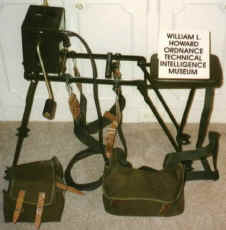|
Home
::
|
Model 50 Hand Cranked Generator
Generator Electronics
The generator must provide AC voltage through three sets of windings. This is passed
through six diodes which convert it to DC which is then fed to a voltage regulating
circuit. The electronics are mounted on a Printed Circuit board which can be removed for
repairs and testing using the jumper cable provided.
There are two switches on the top of the generator which are under a small cover. One is
marked Volts or Amps. It is shown on the schematic. The other switch does not appear on
the schematic. A meter is also on top which indicated the voltage being generated and also
amps. I assume this would be used to determine the current the radio was drawing when
transmitting or receiving. The generator data plate indicates 2 Amps at 25 volts and 1 Amp
at 28 volts
Tactical Employment of the radio
The Chinese military is not as dependent on radio communication as the American army is.
In many cases, the subordinate units have a receiver only so they can listen for
instructions but can not ask questions or respond. This set appears to have been designed
for use at company and battalion level. It is probably a replacement for the 102 E sets
and the XD 6 sets.
Without having access to a technical manual or a battery box, it is not possible to
actually determine if this set can be used as a portable set. I think it can used as a
back pack set. The headset/mike cable tends to support the fact that it can be used in
this manner.
Strengths and weaknesses
Principle strength of the set is it's compact size, light weight and rugged construction.
The headset/mike cable and the power connector cables are plug in and have a hold down
screw which make them almost impossible to accidentally pull loose, unlike prior sets.
Major weakness of the radios is the fact that they are not easily repaired. Removal of any
of the modules would require considerable labour. Replacement of one or more of the tuning
modules in the receiver would require removal of all three so that the shaft for the
rotary switches can be withdrawn. In addition, while there are three separate modules, in
the receiver, they are all built on one printed circuit board. Any major damage to a
tuning module requires replacement of all three. It is my opinion that this set is
basically a throw away set. If anything breaks down, throw it away and get a new one.
The transmitter is a bit easier to work on but still repairs are labour intensive.
The headset/mike cable has a 1/4 inch thick cable connecting the mike to the radio. The
headset, however, has a very thin cord which looks like it is easily broken. The key is
not the best key for a tactical radio.
The generator, while well built is on a very flimsy mount. It is obviously designed with a
small stature, light weight person in mind.
The antenna loading coil is another weak area. It has a wire that connects to the various
taps. This wire easily becomes disconnected, just moving the set from room to room.
Walking through a jungle or any tactical situation must make it even more susceptible to
accidental disconnection
Collector Value
Difficult to place a value on this set. It is not readily identifiable as part of the
North Vietnamese or Viet Cong arsenal during the period of the U.S. effort during the
Vietnam War. The radio set alone is probably worth about $150 to $200.00 to a serious
collector. With all the accessories, such as the headset, headset/mike, key, antenna, and
with a technical manual and a schematic, the set should be worth about $400 to $500 to a
serious collector. With the generator, add another $200.00. This set is an interesting
piece of the radio history of the Chinese Armed Forces. It is also one of the first
Chinese military sets to use transistors, a step forward for the Chinese radio industry.
Back to Communication Equipment of The North
Vietnamese Army and the Viet Cong.
Army Radio Sales Co. Home Page.


